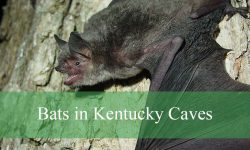Across Arizona’s deserts, grasslands, and mountainous regions, a fascinating variety of wild rabbits thrive, each uniquely adapted to its environment. These small mammals play an important role in the ecosystem, serving as prey for predators and helping maintain plant populations through their feeding habits.
From the common Desert Cottontail to the striking Antelope Jackrabbit, Arizona’s wild rabbits display a wide range of sizes, colors, and behaviors. Observing them in their natural habitats offers a glimpse into their survival strategies and daily routines, from foraging to avoiding predators.
For wildlife enthusiasts, hikers, and photographers, understanding how to identify these rabbits enhances the outdoor experience. This guide covers five of the most notable wild rabbit species in Arizona, detailing their appearance, habitats, behaviors, and tips for spotting them in the wild.
Different Types of Wild Rabbits Found in Arizona
Desert Cottontail (Sylvilagus audubonii)
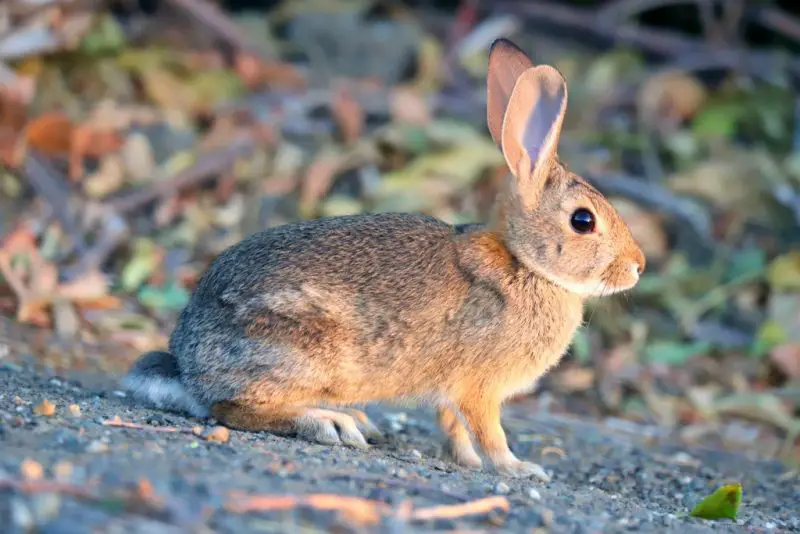
The Desert Cottontail is one of Arizona’s most common rabbits, easily recognized by its pale brown coat, white underbelly, and fluffy white tail. Adults measure 14–18 inches in length and weigh 2–3 pounds. Its strong hind legs allow for rapid, bounding movements to escape predators.
This species thrives in deserts, scrublands, and open grasslands. Crepuscular by nature, Desert Cottontails feed on grasses, herbs, and shrubs during dawn and dusk. Their diet provides much of the water they need, helping them survive in arid conditions.
They take shelter in shallow burrows, natural crevices, or under vegetation. When threatened, they dart in zigzag patterns to evade predators like coyotes, bobcats, and hawks. Multiple litters per year, each with 2–7 kits, help maintain stable populations despite predation.
Their large ears serve dual purposes: detecting predators and regulating body temperature in Arizona’s heat. Combined with behavioral adaptations, these traits make the Desert Cottontail well-suited for life in harsh desert environments.
Eastern Cottontail (Sylvilagus floridanus)

The Eastern Cottontail is less common in Arizona, mostly found in riparian zones, meadows, and grassy areas. Slightly larger than the Desert Cottontail, it has a rich brown coat, grayish underparts, and a distinctive white tail. Adults typically measure 15–19 inches long and weigh 2.5–4 pounds.
These rabbits prefer areas with dense vegetation, which offers protection and ideal nesting sites. They are crepuscular, feeding on grasses, twigs, leaves, and other plant material during dawn and dusk. This diet helps them meet both nutritional and water needs in semi-arid habitats.
Eastern Cottontails nest in shallow depressions under tall grass or shrubs, with litter sizes ranging from 3 to 7 kits. Young rabbits grow quickly, gaining enough mobility to evade predators within a few weeks of birth.
Compared to desert species, Eastern Cottontails have darker fur and a more robust body, making them easier to spot in riparian or forested areas. Their combination of camouflage, speed, and agility allows them to survive alongside a variety of predators.
Black-tailed Jackrabbit (Lepus californicus)
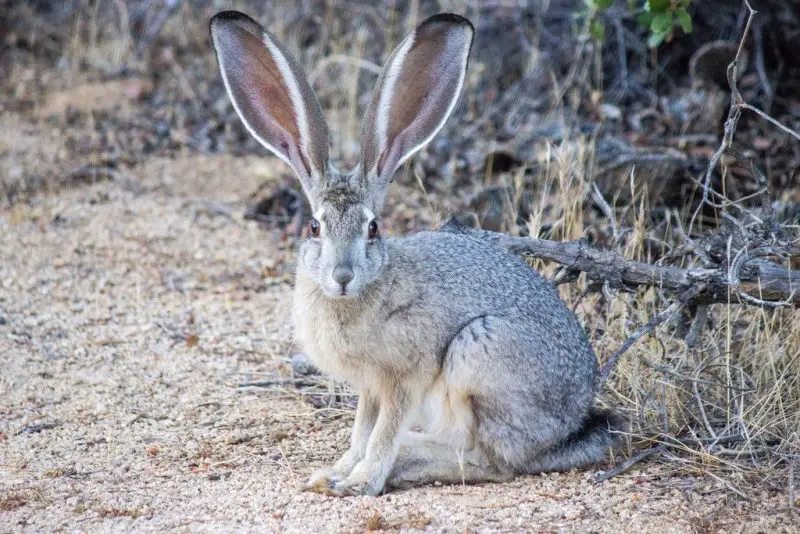
The Black-tailed Jackrabbit is actually a hare, not a true rabbit, and is noticeably larger than cottontails. Adults measure 18–24 inches in length and weigh 3–6 pounds. Its gray-brown fur, pale underparts, and distinctive black stripe along the tail and ears make it easy to identify.
These hares inhabit deserts, grasslands, and shrublands across Arizona. Unlike cottontails, they do not dig burrows, relying instead on speed and agility to escape predators. Primarily nocturnal, their diet includes grasses, shrubs, cacti, and occasionally mesquite pods.
Equipped with long, powerful legs, Black-tailed Jackrabbits can reach speeds up to 35 mph, often bounding in zigzag patterns to evade threats. They are frequently seen darting across open terrain, using quick movements to confuse predators such as coyotes, hawks, and bobcats.
Their large ears serve dual purposes: they provide excellent hearing to detect danger and help regulate body temperature in the hot desert climate. Combined with keen eyesight and alert behavior, these adaptations make the Black-tailed Jackrabbit highly suited to Arizona’s open and arid landscapes.
Antelope Jackrabbit (Lepus alleni)
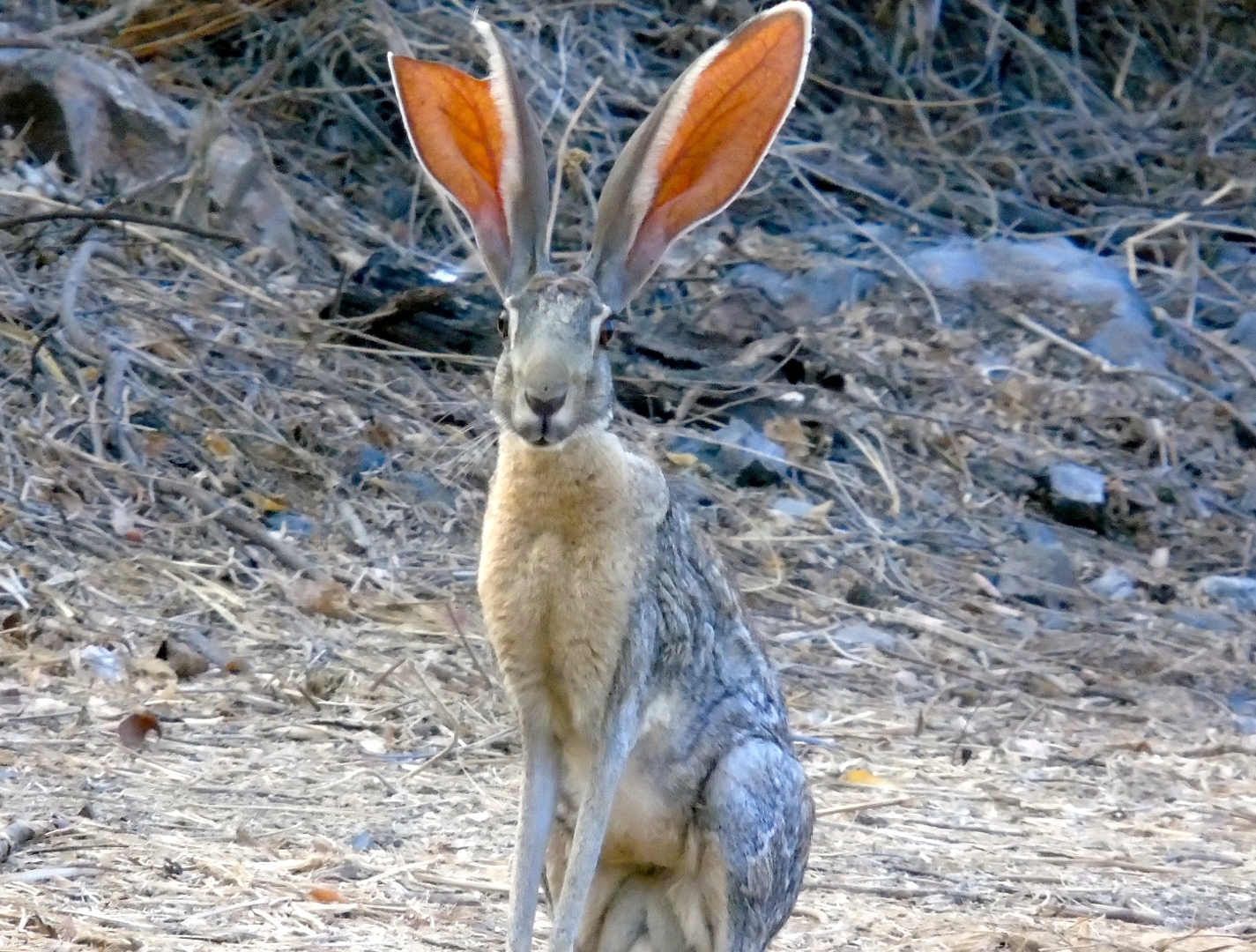
The Antelope Jackrabbit is one of North America’s largest rabbits, measuring up to 26 inches long and weighing 4–6 pounds. Its reddish-brown coat, pale underparts, and extremely long ears—often over 6 inches—make it easily recognizable.
Primarily found in southern Arizona, this species inhabits desert lowlands and scrub habitats. It is nocturnal and crepuscular, feeding on grasses, succulents, and other desert vegetation. The large ears help dissipate heat, allowing it to survive in extreme desert temperatures.
Antelope Jackrabbits rely on a combination of speed and camouflage to evade predators. During mating season, males perform high-speed chases to compete for females, showcasing their agility and endurance.
With strong hind legs, long ears, and keen senses, the Antelope Jackrabbit is highly adapted to life in arid environments, making it one of Arizona’s most impressive desert mammals.
Mountain Cottontail (Sylvilagus nuttallii)
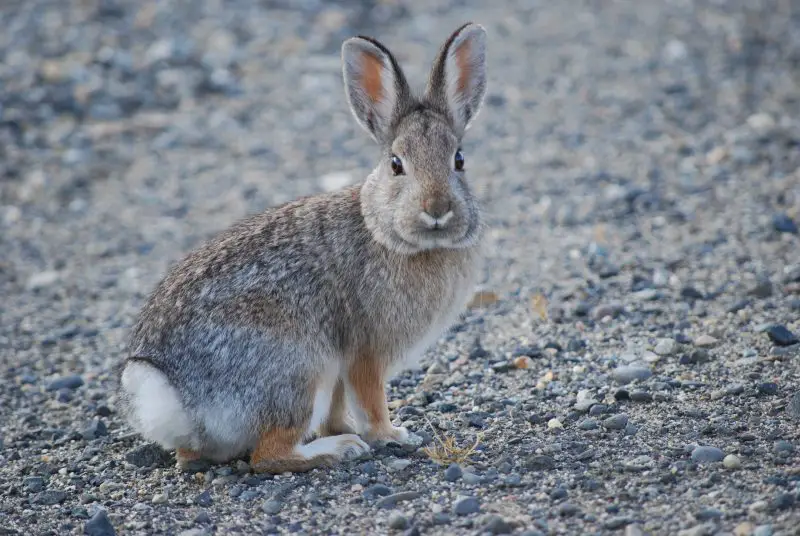
The Mountain Cottontail inhabits higher elevations in Arizona, including forests, meadows, and mountainous regions. It has a gray-brown coat, slightly darker than other cottontails, with a white underbelly and a fluffy white tail. Adults measure 14–18 inches long and weigh 2–3 pounds.
These rabbits feed on grasses, shrubs, and herbaceous plants, favoring areas with dense cover such as rocky outcrops for protection from predators. They are crepuscular, most active during dawn and dusk, and build shallow nests under vegetation for safety.
Litter sizes range from 2 to 6 kits, and multiple litters may occur depending on food availability. Rapid growth of young helps them evade predators effectively.
Thicker fur and behavioral adaptations allow Mountain Cottontails to thrive in cooler, mountainous climates, setting them apart from desert-dwelling species. Their presence highlights the ecological diversity of Arizona’s higher-elevation habitats.
Comparison Table of Wild Rabbits in Arizona
Species |
Size & Weight |
Coat & Color |
Habitat |
Diet |
Key Adaptations |
|---|---|---|---|---|---|
Desert Cottontail |
14–18 in, 2–3 lbs |
Pale brown, white underbelly, white tail |
Deserts, scrublands, grasslands |
Grasses, herbs, shrubs |
Large ears for heat & predator detection |
Eastern Cottontail |
15–19 in, 2.5–4 lbs |
Rich brown, gray underparts, white tail |
Riparian zones, meadows, grassy areas |
Grasses, twigs, leaves |
Darker fur, robust body for camouflage |
Black-tailed Jackrabbit |
18–24 in, 3–6 lbs |
Gray-brown, black stripe on tail & ears |
Deserts, grasslands, shrublands |
Grasses, shrubs, cacti, mesquite pods |
Long legs & ears for speed, hearing & heat |
Antelope Jackrabbit |
Up to 26 in, 4–6 lbs |
Reddish-brown, pale underparts, long ears |
Southern deserts & scrublands |
Grasses, succulents, desert plants |
Long ears & strong legs for desert survival |
Mountain Cottontail |
14–18 in, 2–3 lbs |
Gray-brown, white underbelly, white tail |
Forests, meadows, mountainous regions |
Grasses, shrubs, herbaceous plants |
Thicker fur for cold, high-elevation adaptation |
Best Time and Places to Observe Wild Rabbits in Arizona
Wild rabbits in Arizona are most active during dawn and dusk, as they are primarily crepuscular. These cooler hours allow them to forage safely while avoiding the intense heat of the day. Observing rabbits during these times increases the chances of seeing feeding behavior, social interactions, and their characteristic escape maneuvers.
Different species prefer distinct habitats, which influences where you are likely to spot them. Desert Cottontails are commonly found in open deserts, scrublands, and grasslands throughout Arizona, often near sparse vegetation or rocky areas that provide cover. Eastern Cottontails are more likely to be seen along riparian zones, meadows, and densely vegetated grassy areas in southern and central Arizona.
Black-tailed Jackrabbits inhabit open deserts and shrublands and are easiest to observe in wide, open terrain during dusk when they move actively across the landscape. The Antelope Jackrabbit favors southern Arizona’s lowland deserts and scrub habitats, particularly along desert flats and washes in the evening. Mountain Cottontails are found at higher elevations, including forest edges, meadows, and mountain slopes, and are often seen near rocks and dense shrubs during early morning or late evening.
For the best observation experience, it is important to move quietly and stay downwind of rabbit pathways. Using binoculars can help in spotting rabbits at a distance, especially in open desert or mountainous areas where these animals rely on camouflage and speed. Maintaining distance not only reduces stress on the animals but also increases the likelihood of witnessing their natural behaviors.
Conclusion
Arizona’s wild rabbits and hares are highly diverse, each species exhibiting unique adaptations to survive in desert, grassland, and mountainous environments. From the common Desert Cottontail to the impressive Antelope Jackrabbit, these mammals are integral to the ecosystem, offering both ecological value and observation opportunities for wildlife enthusiasts.
Identifying and understanding these species enhances your experience in the Arizona wilderness and highlights the incredible adaptability of wildlife in challenging environments.
FAQs about Wild Rabbits in Arizona
How can I tell the difference between a cottontail and a jackrabbit?
Cottontails are generally smaller, with shorter ears and tails, and often use shallow burrows or dense vegetation for shelter. Jackrabbits are larger, have longer ears, and rely on speed and agility to escape predators rather than burrows. Observing their size, ear length, and movement patterns can help distinguish them in the wild.
Are wild rabbits in Arizona dangerous to humans?
Wild rabbits are not dangerous, but they can carry parasites or diseases. It is best to observe them from a distance without attempting to touch or feed them. Using binoculars or quietly watching from afar ensures safety for both humans and rabbits.
What do Arizona wild rabbits eat?
Wild rabbits primarily feed on grasses, herbs, shrubs, and leaves. Desert and scrubland species may also consume cacti, succulents, and mesquite pods. Their diets provide both nutrients and water, which is essential for survival in arid environments.
When is the best time to see wild rabbits?
Dawn and dusk are the most active times for wild rabbits, as they are crepuscular. During these periods, they forage for food and interact with their environment while avoiding the heat of the day and many predators.
Where can I find the different rabbit species in Arizona?
Desert Cottontails are common in deserts, scrublands, and open grasslands. Eastern Cottontails prefer riparian zones and meadows. Black-tailed Jackrabbits inhabit open deserts and shrublands, while Antelope Jackrabbits are found in southern lowland deserts. Mountain Cottontails live in forests, meadows, and higher elevations. Choosing the right habitat increases the likelihood of spotting a specific species.


